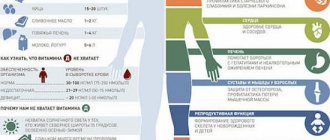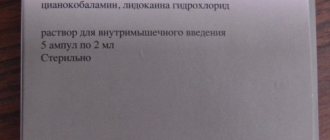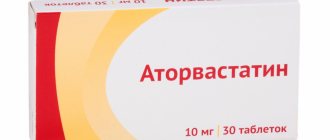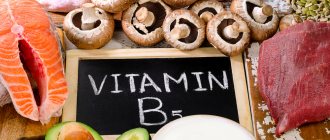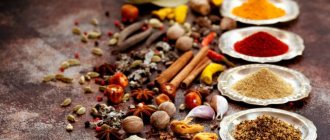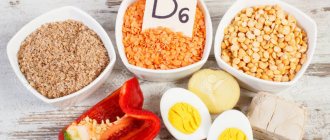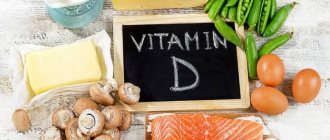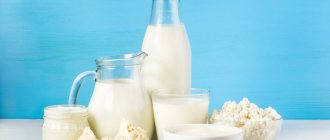Vitamin P or rutin was synthesized from lemon peel in the late 1930s. A special feature of the resulting substance was its ability to strengthen the walls of blood vessels. This factor explains the name, which comes from the English “permeability” - permeability. Vitamin P is a natural bioflavonoid consisting of various chemical compounds.
History of the discovery of flavonoids
In 1936 – 1937, the Hungarian biochemist Albert Szent-Gyorgyi, while searching for anti-scorbutic food factors, synthesized a substance (citrine) from lemon, which exhibited capillary-strengthening properties and enhanced the anti-scorbutic effect of ascorbic acid. The scientist called the new substance vitamin P, and its ability to influence the strength of the vascular wall - P-vitamin activity. The term later spread to other compounds that exhibited similar properties.
During their research, biochemists discovered the commonality of these substances - the presence of aromatic benzene rings in the molecular lattice. In view of this, in 1952, the English scientist T. Geissman proposed assigning the name “bioflavonoids” to group P nutrients. At the same time, the mechanism of their effect on the human body remained unclear for a long time.
In 1971, biologist Richard Passwater made an invaluable contribution to the understanding of the processes that occur when using substances - antioxidants, including flavonoids. In his scientific works, the chemist described the process of slowing down age-related changes in internal organs by fighting free radicals. 14 years later (in 1985), a group of American scientists led by B. Davis established the fundamental pathways for the formation of flavonoids from plant tissues. These studies became a “breakthrough” in the field of studying the physiological role of group P substances for improving the health of the body.
Currently, no one doubts the origin and biological value of P-vitamin substances.
Video: beneficial properties of vitamin P (rutin)
is not responsible for the accuracy of the information presented in this video clip. Source – First Medical Channel
Sources:
- VITAMIN PROBLEM AND ITS SOLUTION. Bykovchenko I. // Remedium. Magazine about the Russian drug market and medical equipment. – 2013. – October. – pp. 42-45.
- USE OF VITAMINS IN PEDIATRIC PRACTICE. Alekseeva A.A. // Pediatric pharmacology. – 2009. – P. 75-80.
- https://www.pubfacts.com/detail/12945352/Quantitative-analysis-of-rutin-and-vitamin-C-by-NIR-FTIR
- https://www.ncbi.nlm.nih.gov/pmc/articles/PMC5355559/
- https://selfhacked.com/blog/rutin/
- https://www.sciencedirect.com/topics/neuroscience/rutin
Chemical properties
Bioflavonoids, due to the characteristics of the crystal lattice, are classified as phenolic compounds of the C6 – C3 – C6 series. A characteristic feature of these substances is the presence in the structure of benzene rings, which are connected to each other by a three-carbon fragment. At the same time, nutrients differ in the degree of oxidation of propane units, the position and number of hydroxyl groups in the aromatic nuclei. In nature, flavonoids are most often found with four or five hydroxyls per molecule, less often - with one, two or six.
The following substances have a specific feature of increasing vascular resistance: flavonones, catechins, chalcones, flavones, leukoanthocyanins, isoflavones, dihydrochalcones, flavonols, anthocyanins.
Compounds of group P are yellow, orange and yellow-green crystals, most of which are soluble in water, insoluble in chloroform, benzene, and ethyl ether. A distinctive feature of rutin and quercetin is their high melting point. The indicator of the first substance is 180 - 190 degrees, the second - 316 - 317. These substances are difficult to dissolve in boiling water and alcohol, and are practically insoluble in cold water. With aqueous solutions of alkalis, rutin and quercetin form homogeneous mixtures.
When FeCl3 concentrate (1%) interacts with flavonoids in ethanol, the compounds acquire a dark color, namely: in reactions to catechins - a bright crimson hue (when adding a 1% vanillin solution to hydrochloric acid), to hesperedin - orange-red (when reduced magnesium), for flavonols - an intense yellow tone (when mixing an aqueous concentrate of alkali metal hydroxides or ammonia water).
Let's consider why vitamin P is needed, who is suitable for “bioflavonoid therapy”, signs of hypovitaminosis, instructions for use, food sources of the nutrient.
Rutin: description, composition and action
The permeability vitamin or rutin has the following structural chemical formula – C27H30O16. This is a water-soluble substance. Its compound is destroyed when exposed to sunlight, oxygen, or when heated or frozen. The structure is based on a diphenylpropane carbon “skeleton”. Rutin can be used to build biochemically important compounds in the cell. Chemical properties determine its biological role:
- stabilization of the basic substance of connective tissue;
- participation in redox processes;
- stimulating tissue respiration.
It should be noted that scientists have proven the fact that vitamins of group P exhibit their properties much more actively when interacting with other chemical elements, biologically active components and vitamins. So the tandem of vitamins C and P is considered one of the most significant and mutually reinforcing. Therefore, in some sources rutin is also called vitamin C2.
Sources of rutin in food
Vitamin P value
The biological role of flavonoids is to reduce capillary permeability, increase the strength of blood and lymphatic vessels, and as a result, increase blood flow and improve the transport of biological fluids to tissues and organs. In addition, vitamin P normalizes the rheological properties of blood, since it slows down the aggregation of erythrocytes and accelerates tissue metabolism.
Let's look at why the body needs vitamin P.
- Neutralizes free radicals. Vitamin P, being a powerful antioxidant, reacts with heavy metal ions, protecting the body from the destructive effects of oxidized elements. Due to these properties, flavonoids are used to strengthen the immune system, prevent tumors, prevent the appearance of functional disorders, cardiovascular pathologies, and preserve youthful skin.
- Suppresses foci of inflammation by reducing the concentration of C-reactive protein in plasma (an indicator of inflammation in the body) and inhibiting lipoxygenase (an enzyme that transforms arachidonic acid into leukotrienes - mediators of inflammation).
- Enhances the pharmacological properties of ascorbic acid, preventing its oxidation. The simultaneous intake of these substances has a powerful antibacterial effect and prevents the development of infectious diseases.
- Potentiates the production of intra-articular fluid. With a lack of flavonoids, the synthesis of “lubricant” material decreases, which leads to the development of joint pathologies and immobilization.
- Stimulates cellular respiration, as a result of which the risk of developing hypoxia, including in conditions of oxygen deficiency, is reduced.
- Normalizes fat and carbohydrate metabolism. Biologically active flavonoid molecules stimulate the proliferation of peroxisomes (a cellular organelle involved in redox reactions in cells), which, in turn, activate cell nuclear receptors PPAR. PPAR nerve endings control glucose homeostasis and fat metabolism in muscle and liver. Along with this, activated receptors act as molecular sensors of fatty acids, regulating the expression of genes encoding transport proteins and enzymes. At the same time, the latter substances control lipid homeostasis, resulting in stimulation of b - oxidation of fatty acids and improvement of lipoprotein metabolism. In addition, preclinical experiments indicate a positive effect of flavonoids on stabilizing body weight and are used in complex therapy to combat obesity.
- Reduces allergic reactions. Flavonoids (hesperidin, rutin, cyanidin, catechin, quercetin, myricetin) inhibit the production of serotonin and histamine (mediators of inflammation and allergies), providing mild anti-inflammatory, anti-edematous and analgesic effects. Due to these properties, vitamin P is used as an antihistamine to alleviate bronchial asthma.
- Reduces the level of absorption of carcinogenic substances that enter the digestive tract with food (nitrosamines, radionuclides, heavy metals, pesticides).
- Potentiates the synthesis of its own collagen. Bioflavonoids, together with vitamin C, prevent the destruction of hyaluronic acid, as a result of which the strength of epithelial tissues is normalized, the formation of the stratum corneum of the skin is slowed down, and capillary permeability is reduced.
- It has estrogen-like, sedative, hypotensive and analgesic effects. In programs for normalizing hormonal levels, group P compounds are used to stimulate the synthesis of adrenal glands (glucocorticoids) and regulate stress levels (by normalizing the production of adrenaline and norepinephrine).
- Accelerates the rehabilitation period after bleeding by strengthening the walls of capillaries.
- Normalizes the secretory function of the liver and stomach. Vitamin P is “responsible” for the duration of bile secretion, thereby regulating the digestive process. Bioflavonoids, in particular quercetin, are used as part of complex therapy for the treatment of peptic ulcers.
- Reduces the risk of developing atherosclerosis. Group P flavonoids improve carbohydrate metabolism in cells, normalize cholesterol metabolism in blood vessels, and stop inflammatory processes in capillaries, as a result of which the risk of developing hypercholesterolemia is reduced threefold.
- Prevents the occurrence of cataracts. Flavonoid extract strengthens the walls of the eye capillaries and stabilizes the condition of cell membranes. Thanks to this, intraocular pressure is normalized, photo-oxidation in the central region of the retina is prevented and the risk of developing degenerative processes in the eye is reduced.
- Regulates the production of enzymes. Along with histidine decarboxylase, vitamin P inactivates the enzymatic systems of parasites (cholinesterase, glyoxalase, succinoxidase), increasing the viability of “good” enzymes (proline oxidase and xanthine oxidase). In addition, flavonoids help stabilize the physiological functions of the body - homeostasis.
- Prevents functional disorders of the cardiovascular system. The beneficial effect of the vitamin is due to increased capillary circulation, normalization of vascular tone, improvement of the rheological properties of blood, and reduced risk of thrombosis. Regular intake of flavonoids halves the risk of developing atherosclerosis, myocardial infarction, coronary heart disease and hypertensive crisis, especially in cases of heart rhythm disturbances.
In addition, the vitamin-like compound performs the following functions in the human body: stimulates the activity of the endocrine glands, inhibits the proliferation of cancer cells, normalizes blood sugar levels, regulates the secretion of bile, and reduces the manifestation of herpes virus infection.
Instructions for use routine
Bioflavonoids are powerful antioxidants and capillary protectors, with pharmacological properties comparable to ascorbic acid and tocopherol. They are used to protect cells from free radicals, increase immunity, strengthen blood vessels, and improve the health of the body.
Indications for use:
- hemorrhagic diathesis (hemophilia, Schönlein-Henoch pathology, Werlhof's disease);
- hypo- and avitaminosis P;
- superficial thrombophlebitis;
- haemorrhoids;
- bleeding of various origins (gastrointestinal, nasal, pulmonary, eye);
- hemorrhages accompanying infectious pathologies (scarlet fever, measles, viral infections);
- diseases of the digestive tract (gastric or duodenal ulcers);
- allergic inflammation of the walls of blood vessels (capillary toxicosis);
- radiation sickness;
- glomerulonephritis with hemorrhagic syndrome;
- collagenoses;
- skin diseases (wetting eczema, dermatitis, hemosiderosis, toxic erythema);
- rheumatism;
- diseases of the biliary organs;
- damage to capillaries due to the use of salicylates, anticoagulants and arsenic-containing agents;
- Quincke's edema;
- lymphostasis;
- venous insufficiency of the lower extremities;
- septic endocarditis;
- glomerulonephritis;
- hypertonic disease;
- thrombocytopenic purpura;
- phlebeurysm.
Considering the ability of flavonoids to bind inflammatory mediators (histamine and serotonin), which provoke the appearance of pain and tissue swelling, vitamin P in combination with ascorbic acid is prescribed for allergies, bronchial asthma, hay fever, and allergic food reactions.
Instructions for the use of bioflavonoid agents
Vitamin P (tablets, capsules, dragees, powder, granules) is taken orally after meals, dividing the daily dose into 2–3 doses.
The body's daily requirement for vitamin P is:
- for infants and infants up to 2 years – 5 – 10 milligrams;
- for children from 3 to 5 years old – 10 – 15 milligrams;
- for schoolchildren from 6 to 8 years old – 15 – 20 milligrams;
- for adolescents from 9 to 14 years old – 20 – 40 milligrams;
- for adults – 40 – 100 milligrams.
The average therapeutic dosage of the substance is 150 milligrams per day. However, in case of chronic venous insufficiency, diabetic retinopathy, dermatological reactions to radiation therapy, the daily portion of the substance can be increased to 1200 milligrams (under medical supervision).
Contraindications: first trimester of pregnancy, individual intolerance to the substance.
Remember, in some cases, the absorption of flavonoids is slow and asymptomatic. Therefore, if there is a need to take large doses of the substance (1000 milligrams), the effect of the compound is enhanced with organic vitamin C (in equal proportions) and tocopherol. Let's consider the factors that provoke the occurrence of P deficiency.
Side effects
During treatment with Rutin, side effects are rare, but in some cases the following disorders occur:
- excessive gas formation;
- heartburn;
- belching;
- nausea;
- allergic rashes on the body, itchy skin.
Sometimes patients experience hot flashes, migraines, weakness and other negative symptoms. If such signs are detected, it is important to stop taking the vitamin and visit a leading doctor.
Hypo- and hypervitaminosis of vitamin P
Considering that the complex of bioflavonoids is not synthesized by the intestinal microflora independently, it is important to monitor the level of its intake into the body on a daily basis. There are cases when, even with sufficient nutrient intake, a person develops P - hypovitaminosis. Let's look at why this happens.
Reasons for the development of vitamin P deficiency:
- inflammation of the digestive tract, and as a result, impaired nutrient absorption;
- following diets for weight loss for a long time (over six months);
- bad habits that inhibit the absorption of substances through the intestinal wall (tobacco smoking, alcohol addiction);
- poor unbalanced diet.
Flavonoid deficiency most often manifests itself in the winter and spring periods of the year (even in healthy people), since it is at this time that the intake of fruits and vegetables in the body sharply decreases.
A “bright” symptom of rutin deficiency is the appearance of bruises on the skin with minor impact on the body.
Characteristics of P - hypovitaminosis:
- fatigue;
- pain in the legs and shoulders when walking;
- subcutaneous pinpoint hemorrhages;
- weakness, malaise;
- bleeding gums, periodontal disease.
If these symptoms are detected, “bioflavonoid” therapy is immediately started. The dosage and treatment regimen are prescribed by the doctor, focusing on the patient’s condition and the severity of the functional disorder. If P-hypovitaminosis is not stopped for a long time, then serious pathologies develop.
What does long-term deficiency of flavonoids lead to:
- intense hair loss;
- the appearance of a bluish tint to the skin;
- the occurrence of acne;
- frequent nosebleeds;
- loss of teeth;
- damage to internal organs.
In severe cases, due to the fragility of the capillaries, hemorrhage occurs in the brain.
Hypervitaminosis of flavonoids is non-toxic and does not pose a threat to human health. The nutrient does not accumulate in the body, and the excess compound dissolves in water and is excreted in the urine.
Rutin: method of application
The forms in which rutin (vitamin P) is produced are varied. These can be tablets, capsules or fine-crystalline powder that is tasteless and odorless. How to take rutin? The method of application and dosage directly depends on the disease and condition in which the person is currently located. Therefore, be sure to follow the instructions for the drug and the recommendations of your doctor.
!
Rutin is taken orally with water during meals.
The daily requirement for an adult is 25-50 mg/day. When used in athletes, the dose is determined by the duration and intensity of exercise. In therapeutic doses, rutin (vitamin P) is taken no more than 100-200 mg/day. The maximum (daily rate) should not exceed 400 mg/day per day.
Symptoms of rutin deficiency in the human body
Our body always gives signals about its state of health. It is important to be able to recognize them in time. Thus, routine deficiency syndrome, its lack, is manifested by the following symptoms:
- general fatigue, loss of strength;
- irritability;
- hair loss;
- bleeding gums, retinal hemorrhages, nosebleeds;
- pain in the joints;
- acne manifestation;
- the formation of bruises and bruises for no apparent reason.
Such painful conditions that occur due to a lack of rutin and other vitamins are called vitamin deficiency. It is characterized by such a feature as seasonality. This means that these symptoms are most likely to occur in winter and spring, when consumption of fresh fruits and vegetables is limited. And everything that is on the shelves of fruit and vegetable shops, due to long-term storage, has lost its vitamin component and does not carry any benefit.
An excess of rutin is not dangerous and is quickly eliminated, since the excess is very quickly eliminated with decay products. But most likely, a negative consequence can still manifest itself in side effects.
Expert opinion
If, after taking medications with rutin, you experience dizziness, headache, hot flashes, gastrointestinal disorders, or if you develop an allergic reaction, stop treatment immediately.
Vascular surgeon, phlebologist
Osipova Ekaterina Yakovlevna
Rutin for hemorrhoids
In proctology, vitamin P is used to strengthen the walls of blood vessels and capillaries of the venous “network” of the rectum. In the treatment of hemorrhoids, ascorutin or rutin preparations in combination with organic vitamin C (calcium ascorbate) are most often used. The combined use of ascorbic acid and bioflavonoids leads to a decrease in swelling and bleeding in the cavernous tissue, and an improvement in blood microcirculation in the venous network of the rectum. At the same time, rutoside (glycoside of the flavonoid quercetin) strengthens the venous wall of hemorrhoids, suppresses inflammatory processes in them, reduces capillary permeability, prevents thrombus formation, and vitamin C is involved in the formation of collagen in cells, the synthesis of proteins and lipids, redox reactions, metabolism carbohydrates.
The complex effect of substances on the capillaries of the rectum is the key to successful elimination of hemorrhoidal bleeding and prevention of their recurrence in the future.
In addition, vitamin P helps eliminate pain and swelling that occur during exacerbation of pathology. For hemorrhoids, rutin is used at all stages of the disease, regardless of the external or internal location of the node.
During “bioflavonoid” therapy, nausea and headache sometimes occur, which disappear after 5-7 days.
Vitamin P, as part of ascorutin, is prescribed in a dosage of 50 milligrams (1 tablet) 2 - 3 times a day. Duration of treatment – 3 – 4 weeks.
Drugs in this group are used with caution for thrombophlebitis and thrombosis.
Contraindications
Contraindications for the vitamin preparation Rutin are quite limited. This is due to the natural origin of the active component of the product and its good tolerance by the body. Among the prohibitions are:
- first 12 weeks of pregnancy;
- individual sensitivity to the drug.
During treatment, factors that can negatively affect the absorption of the drug by the body should be taken into account. Tobacco, alcoholic beverages, antibacterial medications, acetylsalicylic acid, and the hormone cortisone have a destructive effect on vitamin P.
Metabolism of vitamin compound
Most bioflavonoids belong to the group of polyhydric phenols, as a result of which they “behave” in the body as phenolic compounds. The composition of the aromatic hydrocarbon molecule includes three units that are subject to metabolic changes: the aromatic ring system, phenolic hydroxyl groups and substituents adjacent to the ring. However, the metabolism of bioflavonoids in the human cell has been studied within the framework of a small number of substances from the group of catechins, flavonones and flavones. At the same time, the mechanism of transformation of hesperidin and aglycones (naringin, eriodictyol, hesperetin) from flavonones was studied in detail, and rutin and aglycones (quercetin) from flavones were studied in detail.
In the human body, nutrient particles undergo deep breakdown, which, according to biochemists, makes them difficult to detect and study. In view of this, the mechanism of absorption of vitamin P in the digestive tract is not fully understood. However, scientists experimentally (using paper chromatography and thickening protein-free extracts) revealed the presence of catechins and rutin in urine. In addition, when animals were administered labeled quercetin, biochemists recorded the highest concentration of radioactivity in the blood serum in the large intestine, and when labeled catechins were introduced, in the carbon dioxide of exhaled air.
In experiments conducted on rats (the animals systematically received rutin preparations for two weeks), scientists found that 90% of the mass of the test substance moved into the intestines 4–5 hours after administration, and 10% remained unchanged in the stomach.
A comparative analysis of experiments shows that rutin and quercetin are absorbed into the body much more slowly than catechins. In addition, the first substance is practically insoluble in gastric juice, chyme, saliva, but is broken down in intestinal and pancreatic juices. Based on these experiments, biochemists have established that the metabolism of rutin occurs in the intestines under conditions of alkaline hydrolysis. Moreover, according to some chemists, the physiological effect of bioflavonoids occurs through the endocrine glands. However, due to the fact that vitamin P inhibits certain groups of enzymes, other scientists have suggested that the mechanism of action of bioflavonoids occurs through selective action on certain enzymatic systems that are involved in the regulation of vascular permeability and tissue respiration. Today, the process of absorption and breakdown of vitamin P is under study.
Drinks containing rutin
Green tea, natural coffee, red wine, and beer with buckwheat malt can be a good supplier of vitamin P. Despite the technological operations that grain undergoes during the brewing process, there is evidence that the amount of rutin during malting increases significantly.
Attention! From loose leaf teas, it is better to choose varieties with leaves of the middle fraction. The concentration of rutoside in it is much higher than in large leaf.
Table 3 – Vitamin P content in drinks
| Product | Number of routine |
| Red wine | 10–1,000 mg/dm3 |
| Green tea | 200–250 mg/100 ml |
| Dark beers | 1–6 mg/dm3 |
| Black tea | 2 mg/100 ml |
Vitamin P is also found in natural juices. But the amount of substance in the drink depends on the raw materials.
Interesting! Among modern red wines, the 2010 Merlot variety is recognized as the champion in vitamin P content. Rutin in this drink is 14.6 mg/cu.3.
Bioflavonoids as antioxidant protection for the body
Bioflavonoids are powerful natural antioxidants that protect the cells of internal organs from the destructive effects of free radicals.
This effect is explained by the presence of hydroxyl groups in the structure of the nutrient, which serve as a kind of “traps” for aggressive substances. If there are no antioxidant factors in the human body, free radicals strive to gain the missing number of electrons by forcibly “taking away” particles from the molecules they encounter, causing a chain reaction of deformations. Damage to the cell membrane entails disruption of metabolic processes in the cell, as a result of which it dies. This reaction, called “oxidative stress,” underlies the development of numerous diseases.
In addition, “attacking” substances react with the body’s genetic material, the carrier of DNA information, resulting in unwanted mutations or malignant neoplasms. Along with this, free radicals glue molecules in the tissues of healthy organs, disrupting the natural course of biochemical reactions. This process is especially noticeable on the skin, since due to the grouping of proteins, the dermis rapidly loses turgor, elasticity and firmness, becoming sluggish, wrinkled and rough.
In therapeutic practice, antioxidant compounds, including bioflavonoids, are used to neutralize aggressive molecules with an unpaired electron. When these substances enter the body, they come into contact with oxygen by attaching an unstable molecule. As a result of this reaction, free radicals are deprived of their dangerous activity, since the stability of the molecule is restored.
The ability of a flavonoid to bind oxygen particles depends on the number of hydroxyl groups in the structure of the molecule. The most powerful antioxidants among group P substances are proanthocyanidins.
In addition, some polyphenolic compounds, in particular resveratrol and curcumin, suppress cancerous tumors by destroying malignant cells and potentiating the viability of healthy organelles in it. Research conducted at the University of Illinois (USA) confirms that the effectiveness of the use of resveratrol in liver cancer is 37–48%, breast cancer – 43–47%, stomach cancer – 35–41% against the background of the growth of healthy cells – 9–18 %.
Along with antioxidant protection, flavonoids exhibit antifungal and antibacterial properties.
Vitamin P in nature
Bioflavonoids are found in plant organelles: leaves, roots, flowers, fruits, wood and cell sap (in dissolved form). The largest amount of vitamin P is concentrated in the pulp and peel of citrus fruits and rose-flowering crops, which gives them a rich burgundy and purple color (cherry, blueberry, plum).
In the fruits of some plants, flavonoids are concentrated mainly in the skin (apples, cucumbers, pears).
Moreover, each product contains an exceptional composition of flavonoids. For example, beets contain betaine and betanin, blueberries contain anthocyanins, citrus fruits contain flavones and flavonones, and tea (green) contains catechins. Table No. 1 “Which products contain flavonoid extract”
| Product name | Content of flavonoids in 100 grams of products, milligrams |
| Chokeberry | 3000 |
| Cherry | 2300 |
| Honeysuckle | 1300 |
| Rosehip (fruit) | 1000 |
| Lemon, orange | 500 |
| Sorrel | 450 |
| Grape | 430 |
| Barberry | 400 |
| Nectarine, peach | 350 |
| bell pepper | 300 |
| Blueberry | 300 |
| Gooseberry, eshta | 300 |
| Strawberries | 300 |
| Strawberry | 250 |
| Cowberry | 250 |
| Raspberries | 250 |
| Black currant | 240 |
| Red Ribes | 210 |
| Quince | 205 |
| White cabbage | 160 |
| Cauliflower | 140 |
| Potatoes (young) | 100 |
| Lettuce, spinach | 90 |
| Plum | 90 |
| Cherries | 85 |
| Apple | 80 |
| Tomato | 60 |
| Soya beans | 56 |
| Pine nut | 48 |
| Hazelnut | 40 |
| Sesame (cereal) | 34 |
Decoctions of herbs replenish vitamin P reserves well: horsetail, hawthorn, tea leaf, knotweed, licorice, immortelle, tansy, motherwort, hibiscus (hibiscus). At the same time, the concentration of flavonoids in a cup of drink ranges from 40 to 400 milligrams, depending on the type of raw material and the method of steaming.
Drugs
It is not always possible to saturate your daily diet with flavonoids. If natural sources of these substances are not available for consumption, to meet the daily requirement, experts recommend taking biologically active complexes that contain natural extracts from plant materials.
Let's consider popular drugs that have P-vitamin activity.
- “Meliloto Extract + Rutin” is an ampoule preparation based on rutin and sweet clover extract. The medicine has anti-inflammatory, antimicrobial and anti-edematous, vaso- and cytoprotective effects. Injection of rutin is an “express remedy” for strengthening the capillary wall for cellulite, alopecia, and mesotherapy procedures. To improve the condition of hair, the drug is used externally in the form of masks, combined with parenteral administration.
- Venaruton is a medical product for protecting the venous tone of blood vessels. The active ingredient of the drug is rutin. Venaruton is available in the form of capsules, effervescent tablets for oral administration and gel for external use. The content of rutin in capsules is 300 milligrams, in tablets – 1000 milligrams, gel – 20 milligrams per 1 gram of mixture.
- Troxerutin is a semi-synthetic analogue of rutin with P - vitamin activity. The product stabilizes hyaluronic acid in cell membranes, blocks hyaluronidase, reduces capillary fragility and permeability, reduces blood cell diapedesis and exudation of the liquid part of plasma. Direct indications for the use of troxerutin are venous insufficiency, superficial thrombophlebitis, hemorrhoids, varicose veins, impaired capillary resistance, hematomas. The “artificial” flavonoid is available in the form of capsules for oral administration and gel for topical use.
- Ascorutin is a pharmacological agent based on rutin and ascorbic acid. The medicine is used for hypovitaminosis, bleeding, measles, rheumatism, hemorrhoids, hemorrhages in the eyes.
- “Rutin” in tablets is a glycoside obtained from the flowers and leaves of buckwheat. 1 tablet contains 20 milligrams of active substance. The monopreparation is prescribed to strengthen blood vessels and capillaries in order to prevent hemorrhages of various etiologies.
- Chokeberry tablets are an organic preparation obtained from pressed cake of rowan fruits. One tablet contains up to 250 milligrams of vitamin P.
- Troxevasin is an angioprotective drug that contains the semisynthetic flavonoid troxerutin (95%). The medicine is used externally in the form of a gel and orally in capsule form. The vitamin remedy (when used topically) helps to increase venous-arterial reflux, improve microvascular perfusion and microcirculation in the organ. In view of this, Troxevasin gel is an effective “helper” in the fight against venous insufficiency.
- Venomax is a complex preparation based on fragmented salmon DNA and grape seed extract. Field of application parapharmaceuticals: biocorrection of cardiovascular diseases.
- Tea leaf tablets are an organic powder mixture of catechins containing vitamin P at 15, 30 and 50 milligrams per capsule.
- Quercetin is an aglycone of flavonoid glycosides belonging to group P drugs. The plant pigment is prescribed as part of complex therapy for erosive lesions of the oral cavity, periodontal disease, purulent soft tissue diseases, neurocirculatory dystonia, chronic glomerulonephritis, stomach ulcers, and coronary heart disease.
Remember, uncontrolled intake of flavonoids in 50% of cases causes side effects: heartburn, bloating, hot flashes, diarrhea, headache, allergic reactions.
Interaction between flavonoid extract and other substances
On the threshold of the discovery of vitamin factors, component P was removed from the list of essential compounds, since, according to scientists, the nutrient was not one of the essential substances for the human body. However, modern research suggests the opposite, especially in supporting capillary resistance, regulating enzyme synthesis and cellular protection against free radicals.
Let's consider the influence and compatibility of vitamin P on the concentration of other substances.
- Quercetin increases the bioavailability of succinic acid, L-carnitine and polyunsaturated fatty acids (omega 3).
- Vitamin P is destroyed by exposure to oxygen, sunlight and excess heat.
- Alcohol and nicotine reduce the concentration of flavonoids in the body by 3 times.
- Rutin weakens the pharmacological properties of vitamin B1.
- The drug Ascorutin, due to the content of ascorbic acid, enhances the absorption of iron and penicillins, reduces the therapeutic effect of anticoagulants.
- Vitamin P enhances the therapeutic properties of zinc and selenium.
- The bioflavonoids concentrate prevents the oxidation of ascorbic acid, enhancing its pharmacological properties tenfold.
- Vitamin P accelerates the absorption of beta-carotene in the intestines.
- Under the influence of antibiotics, salicylates, glucocorticosteroids and sulfonamides, the flavonoid concentrate is not absorbed.
- Group P substances prevent the development of complications when taking anticoagulants (Syncumar, warfarin).
- Vitamin P, when interacting with carbohydrates, forms complex compounds - glycosides, which protect the body from the adverse effects of the external environment.
- Bioflavonoids combine with each other and organic acids.
Remember, freezing and cooking fresh foods reduces the concentration of vitamin compounds in food by 90%.
Best Rutin Supplements
Not many manufacturers produce rutin. The vitamin is often produced by pharmaceutical companies and sold in pharmacies, which increases its cost. Among the supplements, the most popular choices are:
- Rutin from NOW is the best choice for sports, prevention and people leading an active lifestyle. Each capsule contains 450 mg of substance;
- Biorutin from Nature's Plus is a quality supplement that is available in two versions: 500 and 1000 mg portions of the substance. Mainly used for short-term courses and quick recovery from vitamin deficiency.
Return to list
